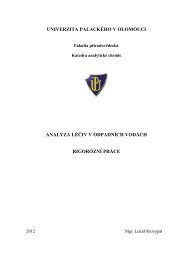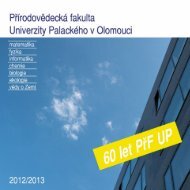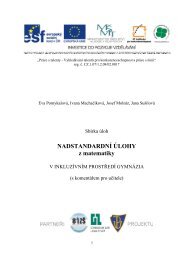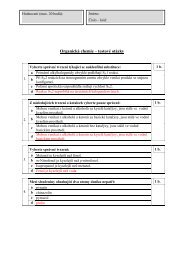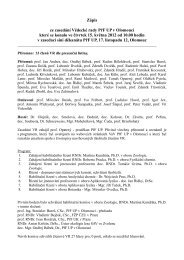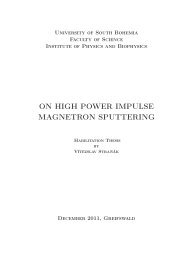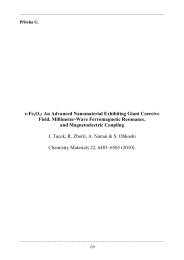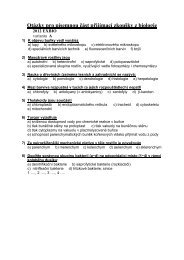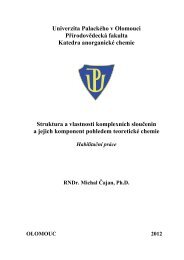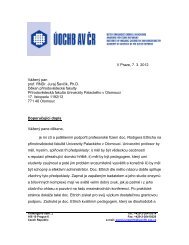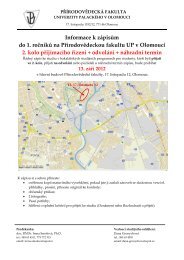A comparative structural analysis of direct and indirect shoot ...
A comparative structural analysis of direct and indirect shoot ...
A comparative structural analysis of direct and indirect shoot ...
You also want an ePaper? Increase the reach of your titles
YUMPU automatically turns print PDFs into web optimized ePapers that Google loves.
4202 Illéš et al.<br />
cell wall thickening <strong>and</strong> callose deposition (Horst et al., 1999;<br />
Nagy et al., 2004; Jones et al., 2006), disintegration <strong>of</strong> the cytoskeleton<br />
(Sivaguru et al., 1999, 2003b), formation <strong>of</strong> myelin<br />
figures <strong>and</strong> membranous electron-dense deposits (Vázquez,<br />
2002), disturbance <strong>of</strong> plasma membrane properties (Miyasaka<br />
et al., 1989; Olivetti et al., 1995; Pavlovkin <strong>and</strong> Mistrík, 1999;<br />
Sivaguru et al., 1999, 2003b; Ahnet al., 2001, 2002, 2004;<br />
Ahn <strong>and</strong> Matsumoto, 2006), as well as the production <strong>of</strong> reactive<br />
oxygen species (Darkó et al., 2004; Jones et al., 2006).<br />
These reactions are only few examples <strong>of</strong> how aluminium<br />
affects the root cells.<br />
The root apex consists <strong>of</strong> the zone <strong>of</strong> cell division<br />
(meristem), followed by the distal <strong>and</strong> proximal transition<br />
zone where cells are prepared for rapid cell expansion<br />
in the elongation zone (Baluška et al., 1990, 1994, 1996;<br />
Ishikawa <strong>and</strong> Evans, 1993; Verbelen et al., 2006). Sivaguru<br />
<strong>and</strong> Horst (1998) discovered that the distal part <strong>of</strong> the transition<br />
zone (DTZ) is the most sensitive part <strong>of</strong> the root to<br />
aluminium stress. Using a sophisticated experimental approach,<br />
they revealed that local applications <strong>of</strong> aluminium<br />
to the rapidly elongating cells do not inhibit their growth,<br />
while local applications <strong>of</strong> aluminium to cells <strong>of</strong> the distal<br />
portion <strong>of</strong> the transition zone dramatically inhibit root<br />
growth. However, it remains elusive which processes specific<br />
to this small developmental window in root cell<br />
development are particularly sensitive to aluminium.<br />
Studies by Kollmeier et al. (2000) indicate that the unique<br />
status <strong>of</strong> auxin in cells <strong>of</strong> the distal portion <strong>of</strong> the transition<br />
zone could be responsible for this high sensitivity <strong>of</strong> DTZ<br />
cells to aluminium.<br />
One <strong>of</strong> the most relevant problems <strong>of</strong> recent research on<br />
aluminium phytotoxicity is to define the primary site <strong>of</strong> its<br />
action at a cellular <strong>and</strong> subcellular level. The crucial question<br />
is whether aluminium acts primarily in the apoplast or in<br />
the symplast. Consequently, the determination <strong>of</strong> primary<br />
cellular mechanisms responsible for the rapid cell response<br />
to the aluminium toxicity is still a matter <strong>of</strong> discussion.<br />
Therefore, it is necessary to characterize the uptake <strong>of</strong> aluminium<br />
into the root cells <strong>and</strong> to monitor its spatial <strong>and</strong><br />
temporal distribution in cells <strong>of</strong> living roots.<br />
Vital staining is one <strong>of</strong> the best <strong>and</strong> rapid methods for monitoring<br />
aluminium localization <strong>and</strong> distribution in plants. At<br />
present, despite some negative views (Eticha et al., 2005),<br />
the aluminium-specific fluorescent dye morin as well<br />
as lumogallion seem to be the best vital fluorescent dyes<br />
for aluminium detection. Both <strong>of</strong> them appear effective in<br />
the nanomolar range <strong>of</strong> aluminium concentrations. The<br />
morin-staining method showed that aluminium was rapidly<br />
taken up into cultured tobacco BY-2 cells (Vitorello <strong>and</strong><br />
Haug, 1996), wheat (Tice et al., 1992), <strong>and</strong> maize root cells<br />
(Jones et al., 2006). Lumogallion staining confirmed the<br />
rapid aluminium accumulation in soybean root cells (Silva<br />
et al., 2000). On the other h<strong>and</strong>, Ahn et al. (2002) reported<br />
that most <strong>of</strong> the aluminium detected by morin was located<br />
preferentially in the cell walls <strong>of</strong> squash root cells within<br />
the first 3 h <strong>of</strong> an experiment. Transmission electron microscopy<br />
studies in combination with energy-dispersive X-ray<br />
<strong>analysis</strong> are approaches giving more detailed information<br />
about the distribution <strong>of</strong> aluminium at the subcellular<br />
<strong>and</strong> ultra<strong>structural</strong> level. Vázquez et al. (1999) observed<br />
the presence <strong>of</strong> aluminium in cell walls <strong>and</strong> vacuoles <strong>of</strong><br />
maize root tip cells after 4 h <strong>of</strong> aluminium treatment.<br />
Interestingly, 24 h <strong>of</strong> exposure resulted in abundant occurrence<br />
<strong>of</strong> aluminium deposits within vacuoles, but less in<br />
cell walls. Accelerator mass spectrometry in single cells<br />
<strong>of</strong> Chara corallina revealed the uptake <strong>of</strong> aluminium<br />
into the cytoplasm during the first 30 min followed by its<br />
sequestration into vacuoles, although intracellular aluminium<br />
represented only 0.5%; the major portion being<br />
apoplastic (Taylor et al., 2000).<br />
Despite extensive research efforts focusing on aluminium<br />
uptake, results are <strong>of</strong>ten conflicting. Most <strong>of</strong> the discrepancies<br />
arise from different methods <strong>and</strong> experimental conditions<br />
(concentrations <strong>of</strong> aluminium, sensitivity <strong>of</strong> methods,<br />
exposure times, cell types, sample processing, etc). In the<br />
studies on intact roots, the particular stage <strong>of</strong> cellular development<br />
(Baluška et al., 1996), reflecting its different sensitivity<br />
to aluminium (Sivaguru <strong>and</strong> Horst, 1998; Sivaguru<br />
et al., 1999), was not always addressed with respect to<br />
aluminium internalization. Therefore, it is difficult to generalize<br />
our knowledge about the uptake <strong>of</strong> aluminium into<br />
plant cells. Moreover, data on the fate <strong>of</strong> aluminium internalized<br />
during plant recovery are completely missing.<br />
To gain a synoptic underst<strong>and</strong>ing <strong>of</strong> aluminium effects,<br />
the extent <strong>of</strong> aluminium internalization into well-defined<br />
cells <strong>of</strong> living roots <strong>of</strong> Arabidopsis thaliana was studied<br />
in a continuous mode under controlled conditions by noninvasive<br />
live microscopy. It is reported that those cells<br />
which are most aluminium-sensitive are also the most<br />
active in the internalization <strong>of</strong> apoplastic aluminium<br />
during recovery. Importantly, endosomal <strong>and</strong> vacuolar compartments<br />
are highly enriched with the internalized<br />
aluminium only in cells <strong>of</strong> the distal portion <strong>of</strong> the transition<br />
zone.<br />
Materials <strong>and</strong> methods<br />
Plant material <strong>and</strong> growth conditions<br />
Seeds <strong>of</strong> Arabidopsis thaliana L., ecotype Columbia, were surfacesterilized<br />
with 0.25% sodium hypochlorite for 3 min, washed <strong>and</strong> sown<br />
on an agar-solidified nutrient medium in Petri dishes. The nutrient medium<br />
was based on Murashige-Skoog salts (Murashige <strong>and</strong> Skoog,<br />
1962) with addition <strong>of</strong> vitamins (myo-inositol 10 mg l<br />
1 , calcium<br />
pantothenate 0.1 mg l<br />
1 , niacin 0.1 mg l<br />
1 , pyridoxin 0.1 mg l<br />
1 ,<br />
thiamin 0.1 mg l<br />
1 , biotin 0.001 mg l<br />
1 <strong>of</strong> medium), FeSO 4 .7H 2 O<br />
(1.115 mg l<br />
1 ), CaCl 2 (111 mg l<br />
1 ), sucrose (10 g l<br />
1 ), <strong>and</strong> agar<br />
(10gl<br />
1 ), the final pH was adjusted to 4.5. The seeds were vernalized<br />
at 4 °C for 24 h. Petri dishes were placed into a growth chamber,<br />
positioned vertically <strong>and</strong> kept under controlled environmental<br />
conditions at 25 °C, 180 lmol m 2 s 1 <strong>and</strong> a 12/12 h day/night<br />
rhythm.




